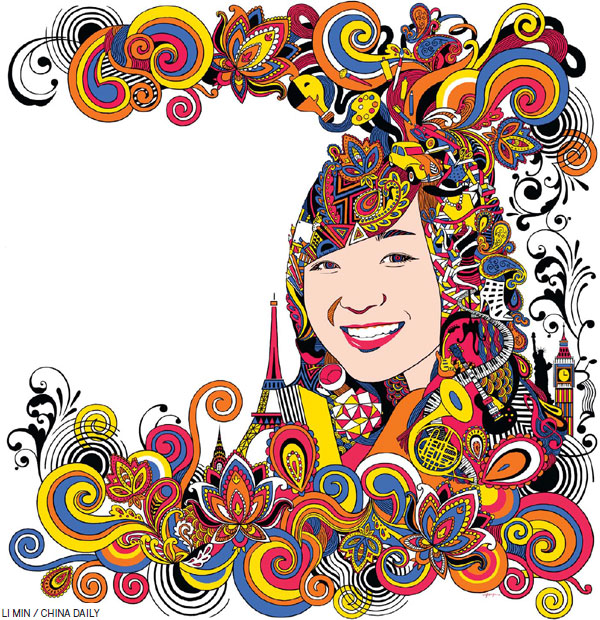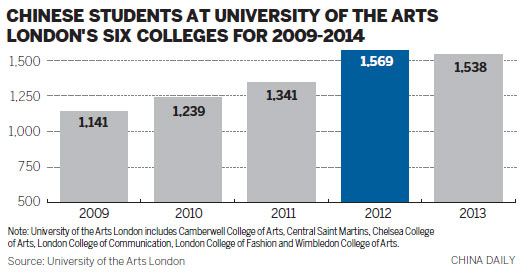Designs on greatness


Overseas training adds piles of talent to Chinese creative pool
Tan Xinyang says he made up his mind to study abroad while visiting a workshop at a design college in Australia a year ago.
"I spent my undergraduate years as an industrial design student at Tsinghua University in Beijing, arguably the best in the country not only for its science education but also for its star-studded design faculty," he says.
"In my junior year, I got the chance to go to the University of New South Wales as an exchange student. There, more than anything else, I was impressed by the level of beauty and sophistication with which the school's design students turned their ideas into reality. The models they made were simply beyond my capability. Profoundly effected and mildly humiliated, I instantly wanted to be one of them."
Tan, 23, standing outside the gate of the UK visa application center in Beijing last month, just after his visa had been granted, saw himself and his dream inching ever closer toward each other.
"A month from now, I'll be sitting in the classroom of the Royal College of Art in London. I got offers and scholarships from a couple of other leading design colleges in Britain and the United States, including the University of Illinois at Urbana-Champaign. But I decided on the Royal College - the only one that did not offer financial support - because that's what I wanted the most. Money is not a problem."
The degree of freedom Tan, whose parents happen to be rich and supportive, is bound to arouse mixed feelings from his fellow design students from humbler families. By enrolling himself into a prestigious overseas art/design college, he has joined a group whose members' fast-growing numbers sometimes belie their status as the absolute social minority in China.
"Over the past five years the number of Chinese students attending overseas art and design colleges, especially in the United States and Britain, has risen sharply," says Que Dengfeng, chairman of Juesheng.com, an education search engine-cum recruiting agency in Beijing for foreign universities that deals mainly with the high end of the market.
"In 2008, we helped nine students to apply successfully for art and design studies with a foreign university," he says. "This included both graduate and undergraduate study."
In the first half of this year, he says, the number was 95, and he estimates that between 2008 and 2013 the total number of overseas art and design Chinese students rose 18 percent a year.
"Last year alone, 50,000 Chinese went to the United States for art and design study, and that figure accounted for about one tenth of the total number of Chinese students heading for the US last year. In 2013, 9,000 Chinese traveled to Britain, to study art and design."
Those figures reflect a trend in China for the past decade, and Que says the figures point to the country's awakening - some may say reawakening - to the power of art and design. That includes an increasingly internationalized domestic market, powered by the rise of the nouveaux riches, many of whom see sophisticated art and design as statements of their refined taste and way of living.
Tan Xinyang owes his entry into the Royal College or Art in no small way to Share With You, an agency in Beijing that specializes in enrolling students in MBA courses. Wang Rui, the agency's director of education counseling, says it began looking at the lucrative field of art and design 18 months ago, and Tan's is just one of several it has successfully handled.
"Most of our clients are attracted by the free-thinking spirit they believe has moored the American and European art education institutions for well over a century," Wang says.
"These young people see themselves in an innovative, iconoclastic environment in which beauty is seen as flowing rather than as fossilized and in which teachers inspire instead of force students to learn."
Another draw, says Ye Shiteng, 25, a fine arts student at Camberwell College of Arts in London, is the hands-on approach the schools use in teaching.
"Chinese students are accustomed to being taught concepts first, but here we learn concepts as we put them into practice, by making mistakes."
Zuo Wen, 34, a London College of Fashion graduate who returned to Beijing to set up a couture business in 2005, decries the lack of basic training that is given to local fashion design trainees.
"It was extremely hard to find an assistant from local fashion college graduates who had intimate knowledge about the physical process of marking a piece of garment. Some graduates from the Beijing Institute of Fashion Technology handed me beautifully painted pictures of fashion. But when they were asked where the zippers should go to create the structural, ultra-modern looks they had presented on paper, most had no idea.
"It may not be entirely true, but I was later told that for graduation projects, many fashion students turn to tailor shops across the road from the university.
"When I was at college in London, I was required to master the many ways of cutting fabric, dying and embroidering, considered basic skills for anyone who calls him or herself a fashion designer."
Zhao Chao, head of the industrial design department at Tsinghua University, says Chinese design colleges often fail to familiarize their students with other design essentials.
"A good design is one that's realizable and marketable," says Zhao, 40, who has studied industrial design in China and overseas.
"As a result, designers need to be able to communicate effectively with those in charge of bringing the idea to fruition. They must be mindful of the implications of every design decision, and be able to work with people from various spheres and disciplines. Our education is insufficient in that aspect."
However, the superiority of foreign schools is not the sole reason for the decision of many Chinese to study abroad, Zhao says.
"Fierce competition in China is also a big factor. In the past few years, Tsinghua's industrial design department has had an intake of about 20 graduate students a year, and no more than 40 undergraduate students - from well over 20,000 who sit the tests. Competition is cutthroat.
"China may have a thousand universities that offer art and design education, but the number of those at the top of the pile is in single digits. For a long time, students and their parents have fallen over one another in the scramble to reach the top, before realizing there is an alternative route."
Que from the recruiting agency blames the top Chinese art and design schools for what he calls "the trade in selling dreams of being a star".
Following an artistic career is often touted as pursuing stardom, Que says, with celebrities such as the pianist Lang Lang held up as role models.
"This be-somebody-or-nobody approach is highly misleading, and has hurt many middle-class Chinese families who have gambled their fortunes on a promise that in reality very rarely delivers. In contrast, in other countries with fully developed commercial cultural markets, a reputed art or design college trains their students to be professionals, with all skills related to the development of a professional career out in the market."
In some Western countries, including Britain, education has been commercialized for decades, with tuition fees from foreign students being an important source of revenue for universities and training colleges.
This has long left schools open to the claim that making money has become their main priority. The current rise in the number of Chinese students in top art and design colleges in Britain and the US has only served to reinforce this claim.
"There's a feeling that top British art schools have become the latest bastion to be breached by the all-powerful 'Beijing pound'," says Tan, whose tuition fee at the Royal College of Art is 27,900 pounds ($47,000; 35,000 euros) a year, compared with the yearly 10,000 pounds charged for international students by an average non-art college in the country. The undergraduates are generally required to pay more. This does not include the high living expenses, as well as the other costs involved in studying art and design such as buying materials."
Another oft-cited case is Central Saint Martin's College of Art and Design in London, whose fashion graduates are held in particularly high esteem. Ten years ago there were few Chinese studying there, but now there is a veritable influx of them into the century-old college.
Jo Ortmans, head of external relations at the University of Arts London, made up of six colleges, including Central Saint Martins, Camberwell College and the London College of Fashion, says school authorities welcome the change in enrollments.
"We are seeking to maintain the current levels of Chinese students as we have strong demand and high quality applicants from both the Chinese mainland and Hong Kong, especially at undergraduate level," she says.
"International students make up 35 percent of the student body and within that group, Chinese students are currently around 30 percent. There are no disadvantages to having Chinese students at the university They all add greatly to the diverse and exciting mix of the creative culture here."
But not everyone is convinced. "Young Chinese going abroad to study art and design generally fall into two categories: those who know what they want and those who don't," says Li Yizhou, 30, a fellow Tsinghua alumnus of Tan.
"Most of the first group have been in art and design, either for personal or family reasons. Many in the second group have scant previous contact with the field. And some choose to study it simply because the bar is not as high as, say, the one set for scientific and literary subjects. Or at least that is the common perception."
Enrolling in arts and design courses makes sitting English-language proficiency tests easier, he says. "They still need to sit the tests, but the requisite marks are much lower. Chinese art and design colleges greatly emphasize future students' basic training, while Western art and design colleges traditionally give greater recognition to a person's talent or creative potential. What has happened is that some applicants have been taking advantage of this flexibility, often with the help of recruiting agencies."
In a recent CNN news report, some Chinese recruiting agencies were accused of cheating to get their clients into foreign universities.
Que himself acknowledges that he has hired "a team of art and design professionals" to do "tutorial or consultative sessions" with the company's student clients, but he sees the nature of his business differently.
"An art/design student's application is built around what is called their portfolio, a collection of works showcasing their creativity. Chinese students do not lack in creativity; what they do lack is the ability to conceptualize their works, to simultaneously show the uniqueness and interrelatedness of each of the works. And in that, we have a vast pool of professionals on hand to help, including some in leading foreign art and design institutions who have first-hand knowledge of how to make a portfolio stand out and impress."
If a client, usually a younger one, needs prolonged and intensive coaching, the cost starts at about 50,000 yuan ($8,100; 6,000 euros), and it could easily reach 250,000 yuan.
"In rare cases, we charge up to 450,000 yuan for more comprehensive services including flying our clients to Europe and the US for long-term one-to-one sessions with a highly regarded artist/designer in the field, or arranging for their internship with leading design firms who act as our local partners. It's fair to say that we don't just help with the portfolio, for those who can afford it. We help with the development of a client's genius before it can be seen by the university he or she is aiming for."
One of the foreign coaches is Evan Douglis, dean of the School of Architecture at Rensselaer Polytechnic Institute, in New York state. Douglis says he coaches applicants on "how to present the idea behind the picture".
Tan says that the universities, especially the top ones, can always discern which applicants are talented and which ones are cheats.
"Given the amount of application materials university recruiting officers see from year to year, it wouldn't be particularly hard for them to pick out the really original ones from the copycats that rely heavily on packaging."
There is no doubt that in the West, particularly in recent years, studying art and design has become extremely expensive.
"Many parents tell me that by funding their children's overseas education in art and design, all they want for their next generation is happiness," says Wang of Share With You.
"This totally relaxed attitude, slightly offensive to middle-class sensibilities, I guess, points to the immense wealth this privileged group commands."
Que agrees. "Let's face it: if wealth makes a difference in people's lives, then this difference becomes more amplified nowhere else than in education. These students may have become the objects of envy, but believe me, it's just the start."
Zhou Heran contributed to this story.
Contact the writer at zhaoxu@chinadaily.com.cn
| Chinese students work on their designs at the London College of Fashion at University of the Arts London. Zhou Heran / for China Daily |

(China Daily European Weekly 08/08/2014 page1)
Today's Top News
- New engine powers cargo drone expansion
- China to boost intl cooperation on green tech
- Factory activity sees marginal improvement in November
- Venezuela slams US' 'colonial threat' on its airspace
- Xi: Strengthen cyberspace governance framework
- Takaichi must stop rubbing salt in wounds, retract Taiwan remarks































